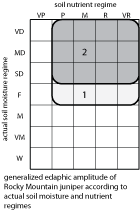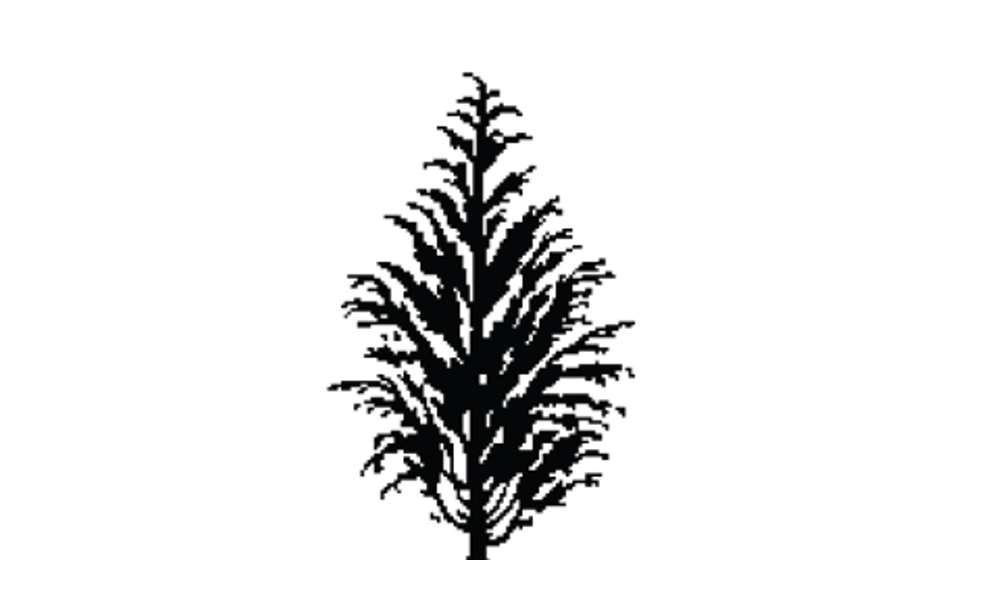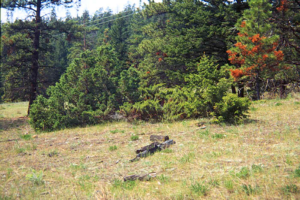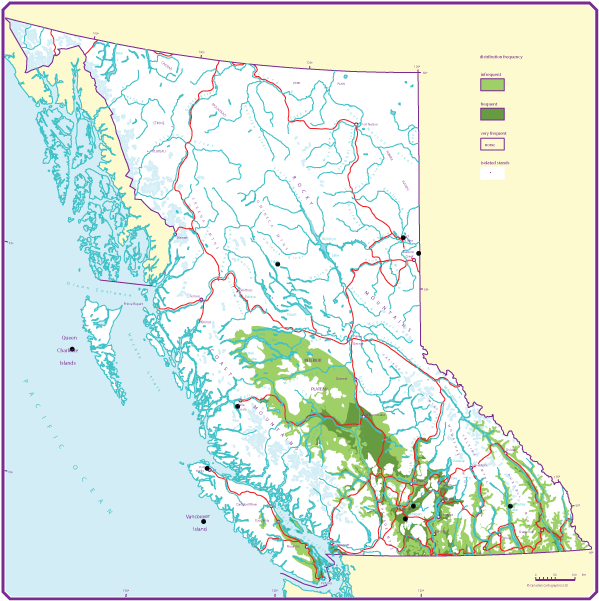Rocky Mountain juniper
On this page
- Geographic range and ecological amplitudes
- Tolerances and damaging agents
- Silvical characteristics
- Genetics and notes
Geographic range and ecological amplitudes
Description
Rocky Mountain juniper varies in size from a shrub to small-sized (rarely >10 m tall) tree. It is an evergreen, scale-leaved conifer, at maturity with a tapered stem, long branches, and fibrous stringy bark. In British Columbia, it is not used for any wood products; however its wood is attractive—fine grained, with white sapwood and deep red heartwood, is resistant to decay, and very fragrant.
Geographic range
Geographic element:
Western North American/mainly Cordilleran and less Pacific
Distribution in Western North America:
(central) in the Pacific region; central and south in the Cordilleran region
Ecological amplitudes
Climatic amplitude:
montane boreal - cool temperate - cool semiarid - cool mesothermal
Orographic amplitude:
submontane - montane
Occurrence in biogeoclimatic zones:
(BWBS), (MS), (SBS), (SBPS), (BG), (PP), IDF, ICH, CDF, (southern CWH)
Edaphic amplitude

Range of soil moisture regimes:
very dry - moderately dry - slightly dry - (fresh)
Range of soil nutrient regimes:
poor - medium - rich - very rich; calciphyti
Tolerances and damaging agents
Root system characteristics
Rocky Mountain juniper has a shallow but fairly extensive lateral root system. Roots are associated with vesicular-arbuscular mycorrhizae.
| Tolerance to | Tolerance class | Comments |
|---|---|---|
| Low light | L | rarely grows in closed-canopy stands |
| Frost | H | tolerates growing season frost |
| Heat | H | Frequent on insolated sites. |
| Water deficit | H | Frequent on excessively dry sites. |
| Water surplus | L | Probably low; absent on water-surplus sites. |
| Nutrient (mainly N) deficiency | H | Common on poor sites but absent in acid, very poor soils; tolerates alkaline soils. |
| Damaging agent | Resistance class | Comments |
|---|---|---|
| Snow | L | uncommon in high snow fall areas |
| Wind | H | common on wind exposed sites |
| Risk class | ||
|---|---|---|
| Fire | H | not a fire resistant species |
| Insect | L | Not a serious concern. |
| Fungi | M | Not a serious concern; juniper blight. |
Associated tree species and successional role
In British Columbia, Rocky Mountain juniper grows in isolated clumps of one or several trees, rarely in open-canopy stands. Occasionally, it associates with Pacific madrone, Subalpine larch, Whitebark pine, Western white pine, Trembling aspen, and Common douglas.
Genetics and notes
Genetics
Information on population variability of Rocky Mountain juniper is incomplete. Hybridization with other junipers is common and complex. No subspecies have been identified but several horticultural and ornamental varieties have been reported.
Notes
Noble, D.L. 1990. Juniperus scopulorum. Pp. 116-126 in R.M. Burns and B.H. Honkala (technical coordinators) Silvics of North America, Vol. 1. Agri. Handbook 654, USDA For. Serv., Washington, D.C.
In addition to Rocky Mountain juniper, there are two shrub junipers native to British Columbia: creeping savin juniper (Juniperus horizontalis Moench) and the wide-spread mountain juniper (Juniperus sibirica Burgds.); the former is restricted to the BWBS zone, the latter occurs throughout the province. More detailed silvics information is given by:
Rocky Mountain juniper is not grown for timber production anywhere in its range. It is used mainly in landscape, restoration, and reclamation planting.

This is the general shape and outline of the Rocky Mountain juniper.

Scattered Rocky Mountain juniper in a parkland-like common douglas and ponderosa pine forest west of Ashcroft.

